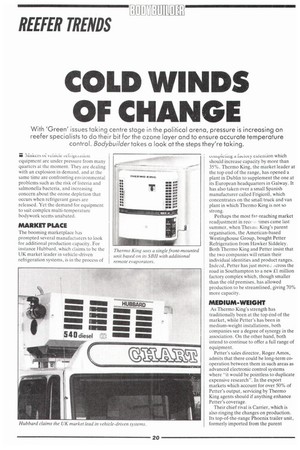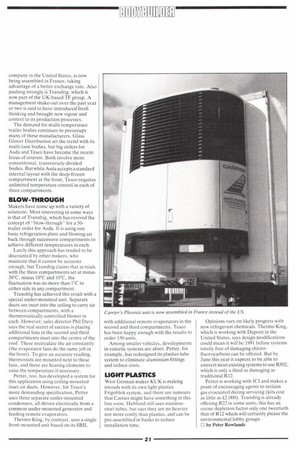COLD WINDS OF CHANGE
Page 144

Page 145

If you've noticed an error in this article please click here to report it so we can fix it.
With 'Green' issues taking centre stage in the political arena, pressure is increasing on reefer specialists to do their bit for the ozone layer and to ensure accurate temperature control. Bodybuilder takes a look at the steps they're taking.
Makels uivcilicie left igc, a tiuti equipment are under pressure from many quarters at the moment. They are dealing with an explosion in demand, and at the same time are confronting environmental problems such as the risk of listeria and salmonella bacteria, and increasing concern about the ozone depletion that occurs when refrigerant eases are released. Yet the demand for equipment to suit complex multi-temperature bodywork seems unabated.
MARKET PLACE
The booming marketplace has prompted several manufacturers to look for additional production capacity. For instance Hubbard, which claims to be the UK market leader in vehicle-driven refrigeration systems, is in the process of
CUllipkillIg a £a..iuiyexteniion which should increase capacity by more than 35%. Thermo King. the market leader at the top end of the range, has opened a plant in Dublin to supplement the one at its European headquarters in Galway. It has also taken over a small Spanish manufacturer called Frigicoll, which concentrates on the small truck and van plant in which Thermo King is not so strong.
Perhaps the most far-reaching market readjustment in rect. . :Imes came last summer. when Thei nu, King's parent organisation, the American-based Westinghouse Group, bought Petter Refrigeration from Hawker Siddeley. Both Thermo King and Petter insist that the two companies will retain their individual identities and product ranges. Indeed, Petter has just move.: across the road in Southampton to a new £1 million factory complex which, though smaller than the old premises, has allowed production to be streamlined, giving 70% more capacity.
MEDIUM-WEIGHT
As Thermo King's strength has traditionally been at the top dad of the market, while Petter's has been in medium-weight installations, both companies see a degree of synergy in the association. On the other hand, both intend to continue to offer a full range of equipment.
Petter's sales director, Roger Amos, admits that there could be long-term cooperation between them in such areas as advanced electronic control systems where "it would be pointless to duplicate expensive research". In the export markets which account for over 50% of Petter's output. servicing by Thermo King agents should if anything enhance Petter's coverage.
Their chief rival is Carrier, which is also ringing the changes on production. Its top-of-the-range Phoenix trailer unit, formerly imported from the parent company in the United States. is now being assembled in France. taking advantage of a better exchange rate. Also pushing strongly i Transfrig, which is now part of the UK-based IF group. A management shake-out over the past year or two is said to have introduced fresh thinking and brought new vigour and control to its production processes.
The demand for multi-temperature trailer bodies continues to preoccupy many of these manufacturers. Glass Glover Distribution set the trend with its multi-lane bodies, but big orders for Asda and Tesco have become the recent focus of interest. Both involve more conventional, transversely-divided bodies. But while Asda acceptsa standard internal layout with the deep-frozen compartment at the front. Tesco requires unlimited temperature control in each of three compartments.
BLOW-THROUGH
Makers have come up with a variety of solutions. Most interesting in some ways is that of Transfrig, which has revived the concept of "blow-through" for a 50trailer order for Asda. It is using one basic refrigeration plant and blowing air back through successive compartments to achieve different temperatures in each.
Lately this approach has tended to be discounted by other makers, who maintain that it cannot be accurate enough, but Transfrig claims that in trials with the three compartments set at minus 38°C, minus 10°C ahd 10°C, the fluctuation was no more than 1°C to either side in any compartment.
Transfrig has achieved this result with a special under-mounted unit. Separate ducts are inset into the ceiling to carry air, between compartments, with a thermostatically controlled blower in each. However, sales director Phil Davy says the real secret of success is placing additional fans in the second and third compartments inset into the centre of the roof. These recirculate the air constantly (the evaporator fans do the same job in the front). To give an accurate reading, thermostats are mounted next to these fans, and there are heating elements to raise the temperature if necessary.
Petter, too, has developed a system for this application using ceiling-mounted inset air ducts. However, for Tesco's more demanding specification. Petter uses three separate under-mounted condensers, all driven electrically from a common under-mounted generator and feeding remote evaporators.
Thermo King, by contrast, uses a single front-mounted unit based on its SIMI, with additional remote evaporators in the second and third compartments. Tesco has been happy enough with the results to order 150 units.
Among smaller vehicles, developments in eutectic systems are afoot. Petter, for example, has redesigned its plastics tube system to eliminate aluminium fittings and reduce costs.
UGHT PLASTICS
West German maker KUK is making inroads with its own light plastics Frigoblok system, and there are rumours that Carrier might have something in this line soon. Hubbard still uses stainlesssteel tubes, but says they are no heavier nor more costly than plastics, and can be pre-assembled in banks to reduce installation time. Opinions vary on likely progress with new refrigerant chemicals. Thermo King, which is working with Dupont in the United States, says design modifications could mean it will be 1991 before systems totally free of damaging chlorofluorocarbons can be offered. But by June this year it expects to be able to convert most existing systems to use R502, which is only a third as damaging as traditional R12.
Petter is working with ICI and makes a point of encouraging agents to reclaim gas evacuated during servicing (kits cost as little as £2,000). Transfrig is already offering R22 in some units; this has an ozone depletion factor only one twentieth that of R12 which will certainly please the environmental lobby groups.
D by Peter Rowlands
































































































































































































